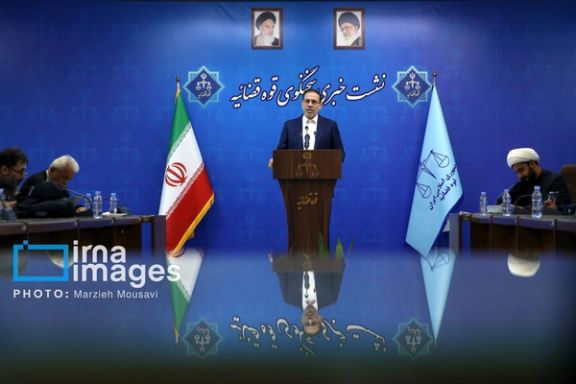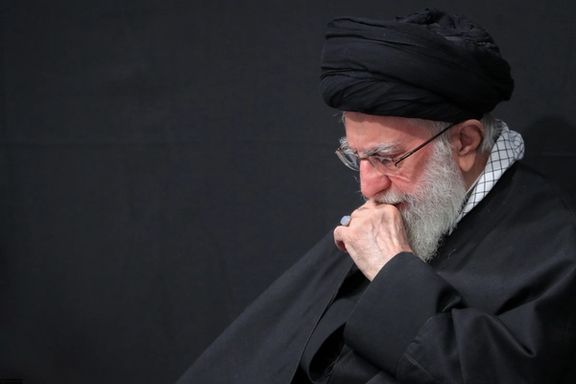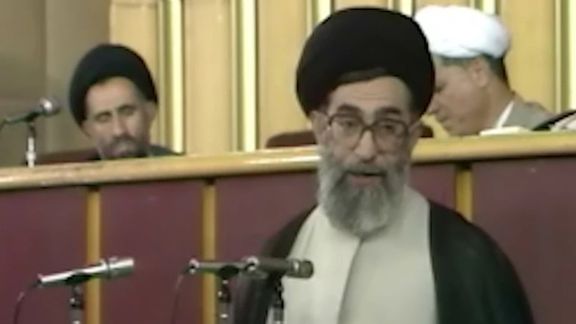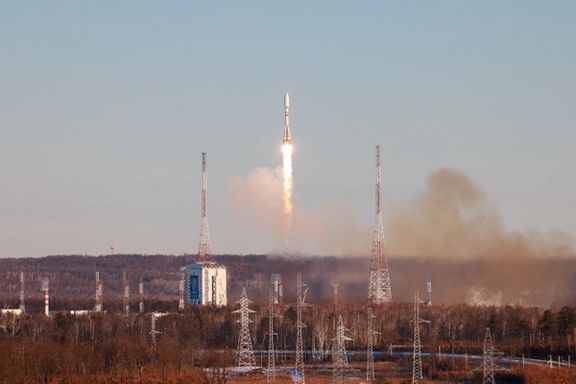Iran belatedly announces German national died before execution

Iran’s judiciary on Tuesday said a German-Iranian citizen died of a stroke last week before his scheduled execution, contradicting state media reports but providing few details.

Iran’s judiciary on Tuesday said a German-Iranian citizen died of a stroke last week before his scheduled execution, contradicting state media reports but providing few details.

Iran’s Supreme Leader Ali Khamenei has remained unusually silent on the current US presidential election, despite having commented on nearly every past race over his 35-year tenure, frequently condemning the US political system.
Khamenei’s silence is particularly striking given that Donald Trump—a former president who withdrew from the 2015 JCPOA nuclear deal and imposed “maximum pressure” sanctions, nearly bankrupting the Islamic Republic and pushing it to the brink of collapse—is once again a strong candidate.
At this juncture, Khamenei is in an unprecedentedly weak position. Over the past year, Iran’s economic crisis has worsened, with the currency now worth just 1/10,000th of its value under the monarchy. His strongest regional proxies, Hamas and Hezbollah, have been significantly weakened. Israel has dared to launch an air strike with impunity and there is no end in sight to US sanctions.
Khamenei’s analysis of US elections through the novels of John Steinbeck and Howard Fast
Since Khamenei became Supreme Leader in 1989, the US has held eight presidential elections. Drawing on novels he has read, Khamenei has condemned the US for suppressing leftist groups and has repeatedly labeled both Democratic and Republican presidents as “fools” and “clowns.”

The first US presidential election during Khamenei’s leadership took place in November 1992, though he made no specific comments on it.
The second election, in November 1996, pitted Democrat Bill Clinton against Republican Bob Dole. During the campaign, Khamenei met with Iranian media leaders, where he sharply criticized American democracy. Referencing his favorite leftist author, Howard Fast, Khamenei analyzed the US elections. Drawing on Fast’s novels, likely The Immigrants, he condemned what he called the repression of leftists, socialists, and communists in the US, stating, “Some of his novels have been translated into Persian—read them to see the shocking accounts about leftists!”
In the same meeting, he encouraged attendees to read John Steinbeck’s The Grapes of Wrath, saying, “Read it to understand that the so-called center of democracy, praised by those with bad taste in Iran, couldn’t even tolerate leftists, as they believed Marxism challenged the American capitalist system.”
A month after the election, on December 6, 1996, Khamenei again discussed US elections with students, citing a leftist American author, probably Howard Fast, to analyze the election process.
The next US election during Khamenei’s leadership was on November 7, 2000, which saw George W. Bush win. By this time, Khamenei had shifted his approach, remarking in May 2000, “I’m not quoting any fanatical Muslim writer; I’m quoting Westerners themselves. I prefer not to name authors, but American writers explain how elections for city councils, Congress, and the presidency operate. Anyone observing it will see that public opinion has nearly no role.”

In July, he again addressed US elections in a meeting with officials, noting he had told President Mohammad Khatami that “in Western democracies, a group comes to the ballot boxes and votes as the party directs, and that’s the end of it!” He continued, “Here [in the Islamic Republic], people love their officials; it’s not just a voting relationship.”
In September 2000, speaking with Basij students, Khamenei referenced American books he’d read, saying, “Read these American books on media roles and the nature of elections—see how city and governor elections operate. When it comes to presidential and congressional elections, money plays the main role, while people are sidelined; there’s no true democracy.”
In December 2000, Khamenei addressed those upset with his criticism of American democracy: “These aren’t our words, nor are they biased or uninformed. They’re based on Western literature’s prominent figures who acknowledge it—yes, in public, they claim people’s votes count, but in reality, they don’t.”
In the early 2000s, as Khamenei ramped up his attacks on US democracy, he was tightening his grip on Iranian politics, media, and elections, increasing the focus on ideological and political loyalty and bolstering the influence of hardliners.
From accusing Americans of racism to critiquing Occupy Wall Street
In his 2012 Nowruz speech, Khamenei referenced Obama’s 2008 election: “The current US president came in with a message of change, implying the situation was so bad it required change.” Calling Americans “racist,” he said, “They didn’t want to vote for a Black man but did, hoping for change.”
Referring to the Occupy Wall Street movement, Khamenei said, “The Occupy Wall Street movement started in US cities. Is this a good situation? It’s simple math. Americans accepted change, meaning the situation is bad, but nothing has improved. America is struggling.”
A week before the election, he again discussed US politics with students, saying, “Isn’t it disgraceful that presidential candidates try to please Zionists and prove their loyalty? Each tries to show more obedience to the Jewish and Zionist communities, which have trapped them.”
Khamenei’s consistent view on US political parties
The next US election took place on November 8, 2016, with Donald Trump and Hillary Clinton as the main candidates. Khamenei had already weighed in on the upcoming election in his 2016 Nowruz speech, remarking, “In a few months, the US will change its administration, but there’s no guarantee the next one will honor past commitments. The candidates are competing in anti-Iran rhetoric.”
On May 14, 2016, he responded to Trump’s campaign threats to withdraw from the Iran nuclear deal, stating, “We won’t violate the agreement, but if they tear it up, we’ll burn it.”
Two weeks before the election, Khamenei commented on the US debates: “Look at their presidential election; it’s down to two people. Watch their debates and how they treat each other! One of these two will become president.”
After Trump’s victory, Khamenei remarked, “America is America; neither party has ever benefited us. We don’t mourn or celebrate.”
Khamenei’s last notable comment on US elections came on November 20, 2022, when he told citizens in Isfahan, “Since the revolution, every US president has fought us. Some have vanished into history’s trash heap, while others are still alive. From Carter, Clinton, and Obama to Reagan, Bush, and the ‘previous fool’—and now this ‘dazed and confused fellow’ who claims he’ll save Iran.”

Russia launched a Soyuz rocket early on Tuesday carrying 55 small satellites, including two from Iran, Russia's Roscosmos space agency reported.
The Soyuz-2.1 spacecraft lifted off from Russia's Vostochny Cosmodrome Tuesday to take satellites designed to monitor the space weather to the Earth's ionosphere, where the atmosphere meets space.
Roscosmos said that in total, 51 Russian satellites, one Russian-Chinese Device and a Russian-Zimbabwean satellite were put into orbit.
According to Iranian Ambassador to Russia Kazem Jalali, two Iranian satellites, the Kowsar, a high-resolution imaging satellite, and Hodhod, a small communications satellite, were among the satellites carried by the Soyuz.
"In continuation of the development of Iran-Russia scientific and technological cooperation, two Iranian satellites, Kowsar and Hodhod, will be launched to a 500 km orbit of earth on Tuesday, November 5, by a Soyuz launch vehicle,"Jalali said in a post on X Monday.
Iranian media says the Kowsar, which weighs 30 kilograms, has an expected lifespan of three years and the Hodhod, which weighs 4 kilograms and orbits at an altitude of 500 kilometers, can operate for four years.
The Iranian satellites are the first launched on behalf of the country’s private sector. IRNA says they were designed and built by the Omidfaza company, which began designing the satellites in 2019.
The heaviest satellites in the launch were two Russian Ionosfera-M satellites, which weigh 430 kg (948 lb) and their working orbit is at an altitude of 820 km (510 miles).
A Russian-Chinese student satellite Druzhba ATURK was also taken to space in the launch.
In February, Russia launched into space an Iranian research satellite that will scan Iran's topography from orbit, according to ISNA.
In September, Iran’s Revolutionary Guards announced the launch of a research satellite into orbit. Chamran 1 was launched aboard the Qaem 100 solid-fuel satellite launcher, also operated by the IRGC. Iranian media said the satellite was placed into orbit at an altitude of 550 kilometers, marking the IRGC's second orbital mission with this launcher.
While Iran insists that the Chamran 1 is purely a research satellite, designed to test hardware and software systems and demonstrate in-orbit maneuvering technologies, Western officials and experts say it is for military purposes.
"Iran’s space program is a cover for the regime’s longer range strike capabilities and a pathway to an Intercontinental Ballistic Missile (ICBM) that could be used to threaten the US homeland and the European continent," Behnam Ben Taleblu, a senior FDD fellow, told Iran International.
Satellite images suggested Israel struck a major Iranian missile plant during its latest strikes across Iran. The images from Planet Labs showed damage to the Shahroud Space Center which is an IRGC facility understood to be used to produce intermediate-range ballistic missiles that could be used to target Israel.

Iran's strike against Israel could be as early as after US elections polls close and will likely involve Israel's air defenses being the main targets in this round of the long-range missile war.
That would overshadow the winner and sow chaos for whoever becomes the next president during the transition phase, said Farzin Nadimi, a Senior Fellow at the Washington Institute.
Leaders of the Islamic Republic have warned that their response to Israel will be a “punishing” reprisal.
Nadimi, who specializes in the security and defense affairs of Iran and the greater region, said Iran would most likely use Iraq and Syria to launch more precise missiles.
Iran hinted at this in an interview between Kamal Kharrazi, an advisor to Iran's Supreme Leader with Lebanon-based pro Iran broadcast Al-Mayadeen on Friday.
Kharrazi said that Tehran will increase the range of its ballistic missiles that go beyond the self-restricted limit of 2,000 km. Achieving that would require launching from neighbouring ally countries like Iraq and Syria.
Nadimi points to recent reports of missiles moving from Iraq into eastern Syria.
"They [Iran] will want to bring their missiles closer to Israel to improve their range," said Nadimi.
Iraq would likely object, but Nadimi said they would not have the power to prevent Iran from doing it, and Israel is anticipated to launch preemptive strikes at Iraq and Syria.
The Jerusalem Post also reported that "the IDF has not ruled out the possibility of an Iranian response from Syria, Yemen, or Iraq, rather than directly from Iran."
For this strike, Nadimi who specializes in Iran's military capabilities, believes it will launch up to 400 missiles, if not more. The aim: to disable major Israeli air defense sites and defense industries.
There are 4 main air bases: Nevatim, Tel Nof, Hatzerim and Ramon.
Those four air bases were allegedly involved in Israel's latest strike in Iran.
Israel's military said its October 26 attack knocked out Iranian missile factories and air defenses in three waves of strikes in response to Iran's barrage of ballistic missiles on October 1.
There may even be deployment of top line missiles like the Khoramshahr-4 alongside Fattah, Kheibarshekan and Emad, according to Nadimi.
The Artesh, which is Iran's military, along with the use of drones is also another scenario Nadimi foresees.
Jason Brodsky, the policy director for United Against Nuclear Iran, said Iran's army along with proxies and the IRGC could assist Iran's air force and navy.
Brodsky said of note is Artesh's role during the Syrian civil war and its fighter jets striking ISIS in Iraq in 2014.
"The army’s air force and navy platforms have the capability of launching missiles and drones at Israeli targets. That combined with IRGC missiles and drones launched from either Iran or Iraq, Syria, and Yemen is a very realistic possibility," he added.
Israel would retaliate against both Iran and its proxies, which would be a huge risk for Tehran, yet it's a risk that indicates how much the establishment's deterrence has failed, according to Brodsky.
According to state news agency IRNA, Iranian President Masoud Pezeshkian said: “If [the Israelis] reconsider their behavior, accept a ceasefire and stop massacring the oppressed and innocent people of the region, it could affect the intensity and type of our response.”

Iran is set to increase the price of aviation fuel, a move that could significantly impact airfares for domestic flights while the government is testing waters for raising regular gasoline prices.
According to the head of Iran’s Airlines Association, the government’s proposed budget for the next Iranian year (which starts March 21) includes a plan to raise fuel costs for airlines from 6,000 rials (less than one US cent) to 70,000 (about 10 cents), potentially leading to higher operating costs and, consequently, higher ticket prices for passengers.
Airlines in Iran receive heavily subsidized fuel, which contributes to lower ticket prices. The aviation fuel is subsidized more than twice as much as gasoline and diesel sold for passenger cars, buses and trucks.
Even with such cheap fuel, most Iranians cannot afford to buy flight tickets. The average cheapest domestic return ticket for one person costs between 40,000,000 and 60,000,000 rials, roughly half of a typical wage earner's monthly salary. One US dollar currently trades for almost 700,000 rials.
However, the government now aims to reduce this subsidy and increase revenue.
Maghsoud Asadi Samani said that the 11-fold raise means the impact of the each liter of aviation fuel on the total cost per seat hour will increase from 240,000 rials (about 34 cents) to 2,800,000 rials (about $4).
Last month, as President Masoud Pezeshkian presented his government’s first budget outline to the parliament, he told lawmakers that the production cost of each liter of gasoline—excluding crude oil—stands at approximately 80,000 rials (about 11 US cents). Furthermore, imported gasoline costs between 300,000 and 400,000 rials per liter (about 40 to 60 US cents).
Speculation is mounting over a potential gasoline price hike, as the government wavers on implementing these politically charged plans.
In response to comments by some lawmakers that the budget bill includes a 40% increase in gasoline prices, the spokesperson of the Planning and Budget Organization recently said: "There is no provision for a gasoline price hike in the 1404 budget.”
Mojgan Khanlou noted that the budget and budgeting system in Iran are fundamentally not the place to set gasoline prices. "Setting the prices of petroleum products requires decision-making at the highest levels of national management, and any adjustment or pricing needs to be discussed thoroughly across various levels."
She added, "The policy of the Planning and Budget Organization is that any adjustment in this area should be made with collective consensus, and the government’s proposed budget has avoided sudden changes and shock decisions that could impact other markets."
However, lawmakers argue that although there is no specific mention about raising fuel prices, the government has envisioned a significant rise in its revenues from fuel sales.
Hossein Samsami, a member of parliament's economic committee, said this week that the upcoming budget projects over 200 trillion rials (about $300 million) in revenue from gasoline sales, which could lead to a 40% increase in gasoline prices.
Iran's heavily subsidized gasoline costs just 2 cents per liter (or less than 10 cents per gallon), making it one of the cheapest in the world. However, this subsidy comes at a steep price for the government, which spends billions annually to sustain it.
For most Iranians, who earn about $200 per month, a large increase could push an already struggling population to the brink. Violent protests shook Iran in November 2019, when the government suddenly tripled gasoline prices.
On Monday, the CEO of the National Iranian Oil Products Distribution Company, Keramat Veis-Karami, announced a record-breaking surge in gasoline consumption in the Iranian month of Shahrivar (August 22 –September 21), saying that gasoline imports reached 9 million liters per day in this time span.
While Iranian officials frequently assert that gasoline consumption is rising, reports from Iran International reveal that a significant portion of the daily gasoline sold is actually smuggled to neighboring countries due to the stark price disparity.

Iraq’s foremost Shia cleric Grand Ayatollah Ali al-Sistani has urged Baghdad to limit armed power to the government and protect its sovereignty from external interference, in an apparent veiled rebuke of Iran's influence on armed groups.
Meeting Monday with Mohamed al-Hassan, head of the UN Assistance Mission for Iraq (UNAMI), al-Sistani was quoted by the official Iraq News Agency as saying Iraq's progress depends on putting weapons in the state's hands and checking outsiders.
Iraqis must "exert their utmost efforts to overcome their failures, working diligently toward achieving a better future for their country where everyone enjoys security, stability, progress, and prosperity,” INA reported him as saying.
This will be achieved by "preventing foreign interference in all its forms, enforcing the rule of law, restricting arms to the state, and combating corruption at all levels," al-Sistani said, adding: "But it seems that the Iraqis have a long way to go until they achieve this, may God help them."
Al-Sistani is Iraq's preeminent Shia religious authority and an influential voice on public affairs. Along with populist cleric Moqtada al-Sadr, he has been a longtime skeptic of Iranian influence in the country since a US-led invasion in 2003.
However, al-Sistani's 2014 call for armed defense against the expansion of ultra-hardline Sunni Islamic State militants led to the formation of the Popular Mobilization Forces, a grouping of armed factions including some backed by Iran.
His remarks come as Iraq is caught in the middle of broader regional conflicts and hosts US troops at the same time Tehran arms and funds powerful Shia militias.
Iranian-aligned armed groups in Iraq, some of which have publicly expressed support for the so-called ‘resistance axis’ aligned with Gaza, have launched missiles and drones toward Israel, though these attacks have had minimal impact.
The term ‘resistance axis’ was coined by the Islamic Republic to describe its regional proxy forces, including Palestinian militant groups, the Syrian government under Bashar al-Assad, the Lebanese group Hezbollah, Yemen's Houthis and others.
Meanwhile, Shia cleric Ali al-Amin in Lebanon has also called on Lebanese citizens to avoid sectarian divisions and support national unity, asserting that government institutions must protect citizens without partisan or sectarian affiliations.
According to a recent report in The Wall Street Journal, Iran is preparing a retaliatory response to Israel’s latest attacks, potentially involving Iraqi territory as a staging ground and using its conventional military forces.
Iranian officials, briefing Arab diplomats, suggested that their response would focus on Israeli military sites “much more aggressively than last time.”
Iranian President Masoud Pezeshkian also declared that "Iran will in no way leave any violation of its territory and security unanswered."
The Judiciary spokesperson Asghar Jahangir said on Wednesday, “Jamshid Sharmahd's death sentence was set to be carried out, but fate offered no reprieve, and he died before the execution could proceed.”
Jahangir did not explain whether he suffered a stroke or a heart attack, nor did he specify the exact time of death: during transfer for execution, in his cell, or during interrogation.
State media reported the execution of the 68-year-old US-based German citizen on October 28. He was abducted by Iranian agents during a visit to the United Arab Emirates in 2020 and forcibly taken to Iran. In February 2023, Iran's Judiciary sentenced him to death on charges of endangering national security. Tehran says that Sharmahd was responsible for a 2008 attack on a mosque in Shiraz that killed 14 people and injured 200.
Later on Tuesday, a German foreign ministry official said Tehran is responsible for the death of Sharmahd. "Jamshid Sharmahd was abducted by Iran and detained for years without a fair trial, in inhumane conditions and without the necessary medical care. Iran is responsible for his death," Reuters quoted the German official as saying.
Following reports of his death last week, Germany recalled its ambassador to Iran and summoned the Iranian chargé d'affaires. Berlin also ordered all Iranian consulates to be shut down. The European Union also announced it is considering targeted and significant measures against Tehran.
German Foreign Minister Annalena Baerbock said, "Our diplomatic relations are already more than at a low point," after Berlin recalled its ambassador.
Baerbock urged Brussels to put Iran’s Islamic Revolutionary Guard Corps (IRGC) on the European Union's terror list.
Germany downgraded relations with Tehran in the 1990s following the assassination of Kurdish-Iranian dissidents in Berlin. Tensions eased a few years later following the election of reformist Mohammad Khatami, who embarked on a charm offensive to rebuild relations with the European Union.
Iran's Foreign Minister Abbas Araghchi, in response, wrote on X, “No terrorist enjoys impunity in Iran, even if supported by Germany.”
His daughter Gazelle Sharmahd, on X, had demanded proof of his execution and called for the immediate return of her father.